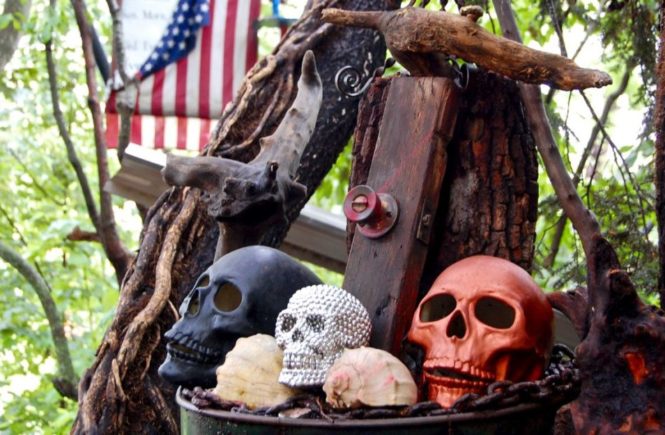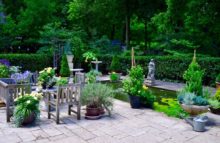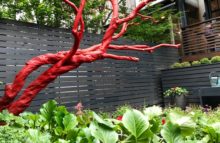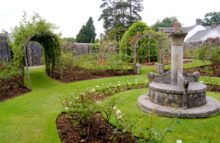Can social change grow alongside art in a garden? I’ve been mulling this question over since Sarah and I returned from the annual garden bloggers’ meet-up, known as the Fling.
This year, the Fling was flung in the trendy Appalachian town of Asheville, North Carolina. The Battersby Girls (plus Sarah’s son J, a good sport) were the sole Canadian reps joining about 85 bloggers from all over the U.S.
The range of gardens we saw was amazing. Among them was the Burton Street Community Peace Gardens in West Asheville. On so many levels, this community garden, ongoing art installation and neighbourhood party central was thought provoking and inspiring.
The garden is the brainchild of West Asheville couple DeWayne Barton and Safi Mahaba. Barton is also the co-creator of Green Opportunities or GO!, where he helps give at-risk youth the skills and training to become workers in green-collar industries. In the Burton Street garden, Mahaba is the gardener, Barton is the art-maker. Both have been community and social activists in the space for over a decade.
Yes, this is a space in which to grow plants. Veggie beds and flowers are the first things that greet you as you enter. But the most arresting aspect of the garden is the decidedly political and, to me, exciting artwork scattered all through it, constructed of reclaimed materials. Junk, Barton calls it. Some, like the ones above, are distinctive pieces. Others have a sense of controlled chaos. For kids, it must be nirvana.
It has to be a tough job engaging marginalized young people, turning them around from cynicism to optimism. Boundary-bashing artwork offers a doorway to self-expression. It lets them put their views out there, and see themselves reflected in the world – rather than apart from it. It can be a way in, as well as a way out. I wish we’d had more time in all the Asheville gardens, but this one especially.
Safi Mahaba poses beside the adobe oven that was a work project for one of Barton’s groups. It takes Mahaba about two hours to fire it up in the traditional way so they can make the wood-fired pizzas that are a regular part of Burton Street community events. The canopy overhead is a recycled satellite dish.
The cool Learning Pavilion was constructed from recycled materials for $3,900. That Texaco sign is a sliding door. This article from The Polis Blog is a must-read about the history of the gardens and process of building the Learning Pavilion. And this Inhabitat article shows you a slideshow about the build.
In Toronto, similar organizations are doing good works in food security, community building and social outreach, and you might want to get involved. Some of them include Food Share, Parkdale’s Greenest City (check out the community art installations on their website), The Stop Community Food Centre, and Afri-Can FoodBasket, which Lorraine Johnson wrote about for Canadian Gardening.
 |
 |










7 comments
Thank you for this article, Helen. I had to miss this garden to help get the lunch food ready for the bloggers. What a wonderful way to involve and help the community, both at Burton Street and in Toronto. Kudos to both, and to you, Sarah and J. for making the trip as Canada's representatives!
Frances
Thanks Helen! Thanks for posting the links for additional information and history on this community garden. Like you, I was fascinated by this space and desirous of a learning pavilion such as this! Garden design is always art, and purposely adding other forms of artistic expression in the space of growing food and holding community is what, "art squared"? Great to meet you in Asheville too!
Wonderful Helen. The extra research, links and info on the Burton Street Community Peace Garden is such a great addition to visiting the garden itself.
Yes, thanks for the extra research Helen and putting it all together for us. Thought provoking indeed.
Thank you. This was a great article and made me appreciate their gardens more. The Garden Junkie.
i wish we would've gotten more of an overview from the garden organizers on site. so many interesting stories to be shared here.
I found this to be a most interesting garden. One that really gave the mind a workout of sorts. Conclusion, a great place to bring the community together…